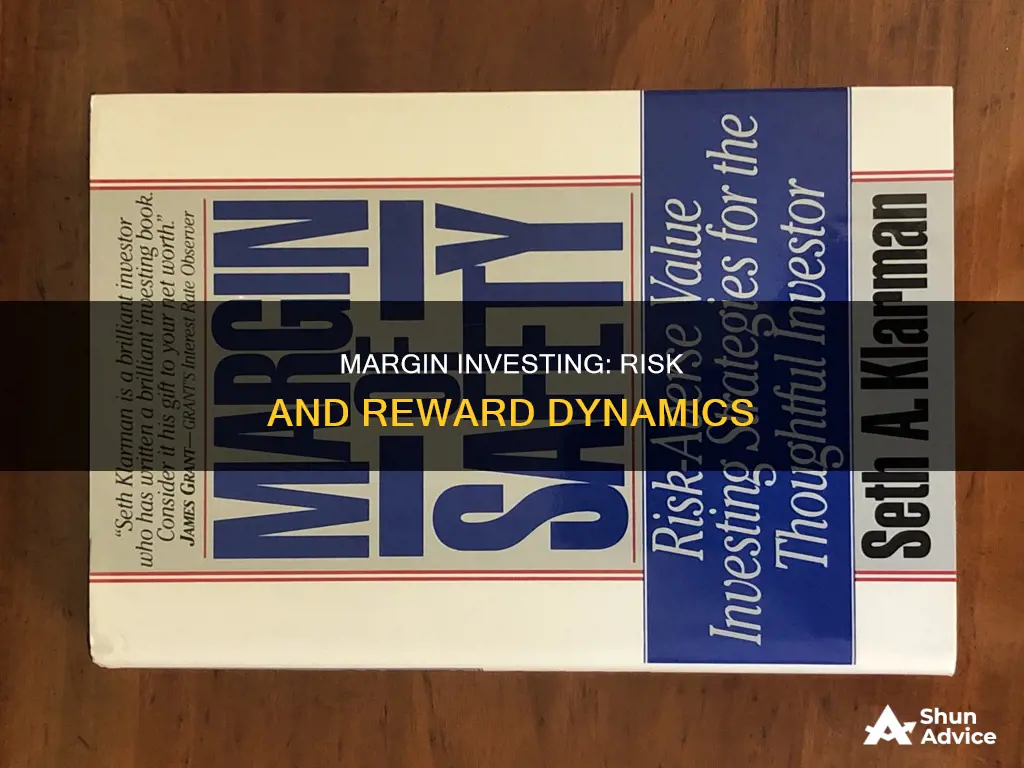
Margin trading is a high-risk strategy that involves borrowing money from a broker to invest in more securities than one could with their own capital. While it can amplify returns, it also magnifies losses. Margin trading is best left to professionals as it requires a solid understanding of the market and careful risk management strategies. The risks of margin calls, high borrowing costs, and amplified losses mean that margin trading should be approached with caution.
| Characteristics | Values |
|---|---|
| Nature of margin investing | Investing with borrowed money and using current investments as collateral |
| Magnification of losses | A decline of 50% or more in stocks that were half-funded using borrowed funds equates to a loss of 100% or more in your portfolio, plus interest and commissions |
| Magnification of gains | Borrowing money to invest can amplify gains |
| Margin call | The broker will issue a margin call if the equity in your account falls below a certain value, demanding that you deposit more funds or sell off some or all of the holdings in your account to pay down the margin loan |
| Interest on borrowed funds | Investors pay interest on borrowed funds, which can add up, especially for long-term positions |
| Risk of losing more than initially invested | In some situations, you might wind up losing more than you initially invested |
| Forced liquidation | Brokers have the right to liquidate your positions if they believe that the value of your account has fallen too much or if you're unable to meet a margin call |
| Delayed capital gains | Margin loans aren't taxable income because you need to repay the money |
| No minimum payments | Interest may accrue daily, but you don't have to make payments as long as you have enough equity |
What You'll Learn

Margin trading magnifies losses
For example, if you buy 2,000 shares of a company with $10,000 of your own cash plus $10,000 in your margin account at a cost of $10 a share, that's a total of $20,000, excluding commissions. If the company then reports disappointing earnings and the stock drops 50%, the position is now worth $10,000, and you still owe the broker that amount for the margin loan. In this scenario, you lose all of your own money, plus interest and commissions.
The magnifying effect of margin trading can also lead to a margin call when losses exceed a limit set by a broker or the broker's regulating body. This "maintenance margin" limit often ranges from 30% to 40% of the value of the securities, instead of the initial 50% required at the time of purchase. If you do not meet the margin call, your brokerage firm can close out any open positions to bring the account back up to the minimum value. They can do this without your approval and without notifying you, and they can choose which positions to liquidate.
The US Securities and Exchange Commission (SEC) warns that margin accounts "can be very risky and they are not suitable for everyone". It adds that investors can "lose more money than [they] have invested" and may be forced to sell securities at a substantial loss.
Where Equity Investments Hide in Financial Statements
You may want to see also

Margin calls can result in forced liquidation
When an investor buys securities on margin, they are borrowing money from a broker to increase the size of their investment. This allows them to potentially magnify their returns if the value of their investment rises. However, if the value of the securities decreases, the investor's equity can fall below the minimum maintenance requirement, triggering a margin call.
A margin call is a demand from the broker for the investor to deposit additional funds or securities into their account to increase its value. If the investor does not meet the margin call, the broker has the right to force the investor to sell their assets to meet the minimum requirements. This is known as forced liquidation.
Forced liquidation can result in significant losses for the investor, as they may be forced to sell their assets at a lower price than they had hoped. It is important for investors to carefully consider the risks associated with trading on margin and to monitor their equity and account value regularly to avoid margin calls and forced liquidation.
Investment Management: A Decade of Portfolio Experience
You may want to see also

Interest payments can erode profits
Interest payments on margin loans can erode profits. As with any loan, you will be charged interest on your margin loan by your broker-dealer. This interest directly reduces your return on investment, increasing the amount your investment needs to earn to break even.
Margin loans are usually subject to periodic interest rates, which must be paid. The interest charges are applied to your account unless you decide to make payments. Over time, your debt level increases as interest charges accrue against you. As debt increases, the interest charges increase, and so on. Therefore, buying on margin is mainly used for short-term investments. The longer you hold an investment, the greater the return that is needed to break even. If you hold an investment on margin for a long period of time, the odds that you will make a profit are stacked against you.
The interest rates on margin loans can vary substantially between brokerage firms. Margin loan rates for small investors generally range from as low as 6% to more than 13%, depending on the broker. Since these rates are usually tied to the federal funds rate, the cost of a margin loan will vary over time.
It is important to carefully consider the expense of interest payments before trading on margin. Interest payments can quickly add up, eroding profits and increasing the risk of permanent losses.
Understanding Your Investment Portfolio Reports: Why They Matter
You may want to see also

Margin trading is not suitable for beginners
- Margin trading is a risky strategy that can result in greater losses due to the use of leverage. When you trade on margin, you are borrowing money from a broker to buy more securities than you could otherwise afford. While this can amplify your gains, it can also magnify your losses. If the value of your securities decreases, you may be forced to deposit additional funds or sell off your holdings to pay down the loan. This is known as a margin call, and it can lead to significant financial losses. Beginners may not have the risk tolerance or the financial resources to handle such situations.
- Margin trading requires a good understanding of the mechanics of trading and the potential risks involved. Beginners may not have the necessary knowledge or experience to make informed decisions about when and how to use margin effectively.
- Margin trading often involves complex strategies such as short selling and options trading, which can be difficult for beginners to grasp. These strategies can carry significant risks, and beginners may not be able to assess these risks properly.
- Margin trading is typically used by professional investors or institutional investors who have a deep understanding of the market and can dedicate significant time to monitoring their portfolios. Beginners may not have the time or expertise to engage in such active trading strategies.
- Margin trading can be costly, as it involves interest charges and account fees. Beginners may not have the financial means to cover these additional costs, especially if their trades are not successful.
- Margin trading requires adhering to strict rules and regulations, such as those set by the Financial Industry Regulatory Authority (FINRA) and the Securities and Exchange Commission (SEC) in the United States. Beginners may find it challenging to navigate these regulations and ensure compliance.
- Margin trading is best suited for investors who can dedicate a substantial amount of time to monitoring their portfolios and making quick decisions. Beginners may not have the time or commitment to actively manage their trades, which could lead to losses.
- Margin trading can be emotionally challenging, as it involves taking on higher risks and dealing with potential losses. Beginners may struggle with the psychological aspects of margin trading and may make impulsive decisions that could adversely affect their portfolios.
Understanding the Risks: Are Any Investments Truly Safe?
You may want to see also

Margin trading is high-risk
Margin trading is considered a high-risk activity due to the potential for amplified losses, the requirement to repay margin loans regardless of investment performance, and the possibility of forced liquidation of assets.
Margin trading involves borrowing money from a broker to purchase securities, essentially taking out a loan to increase one's buying power. While this can lead to higher profits, it also increases the risk of larger losses if the market moves against the investor. The use of leverage in margin trading means that even small market movements can result in substantial losses.
One of the biggest risks associated with margin trading is the potential to lose more money than initially invested. If the value of the securities purchased with a margin loan decreases, the investor may be forced to sell those securities at a loss to repay the loan, resulting in a total loss exceeding the initial investment. This is known as a margin call, where the broker demands more funds or the sale of securities to restore the account balance.
Additionally, margin loans come with interest payments, which can reduce profitability, especially for long-term positions. The longer an investor carries a margin loan, the more they will pay in interest, potentially eroding profits.
Margin trading also exposes investors to the magnified impact of market fluctuations. In highly volatile or declining markets, the risk of margin calls and forced liquidation of assets increases. A sharp drop in investment value can trigger margin calls, and if the investor is unable to cover the shortfall, the broker may sell assets at a loss.
Due to these risks, margin trading is generally not recommended for inexperienced investors, those with low-risk tolerance, or those investing for the long term. It is important for investors to carefully consider the risks and ensure they understand the mechanics of margin trading before engaging in this type of investment strategy.
Savings Glut: When Saving Outpaces Investment
You may want to see also
Frequently asked questions
Margin investing is a type of brokerage account (investment account) that has a line of credit attached to it. It allows investors to borrow money from a broker to trade financial assets and buy more securities than they could with just their own funds.
Margin investing increases your risk because it amplifies both potential returns and losses. If your investments lose value, you may be forced to sell them or put more cash into your account to meet the margin call. You could lose more than your initial investment, and be forced to sell your investments at a bad time.
If the value of your investments drops and your equity falls below the broker's maintenance margin requirement, you will receive a margin call. This means you will need to deposit more funds or sell some of your securities to restore the required minimum equity in your margin account. If you fail to meet the margin call, the broker can sell your securities without your consent.







